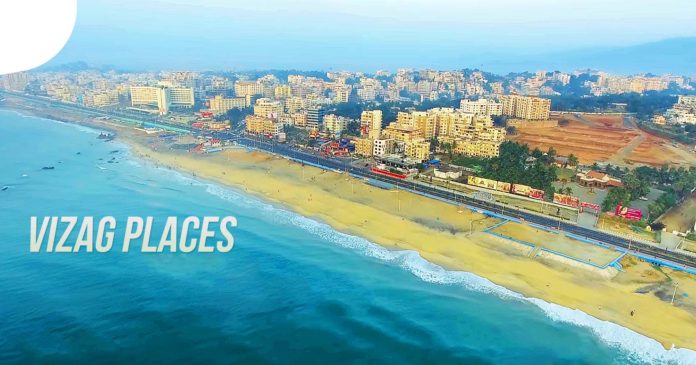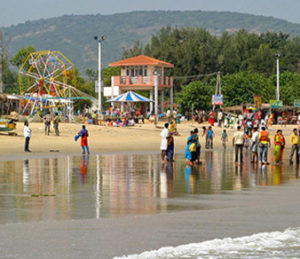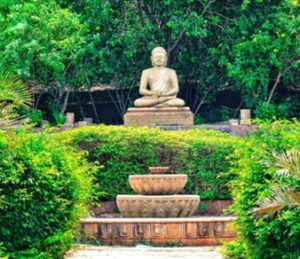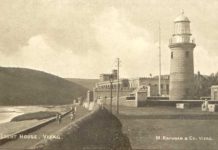Visakhapatnam City
Visakhapatnam is a beautiful city on the east coast of Indian sub continent also known as the “jewel of the east coast” in Andhra Pradesh. Once part of colonial British Empire then named as Waltair; during the colonial era, the city’s hub was the Waltair railway station and the surrounding part still popular as Waltair. Now known as Visakhapatnam each day sunrays first reach the surrounding beaches and kisses to craft it a perfect holiday destination for nature & beach lovers. The Bay of Bengal Ocean on the east and rest three sides covered with beautiful hilly terrain covered with greenery. This started its journey from a small fishing colony to a modern smart city. Visakhapatnam is the district headquarters for eastern naval command which is one of the major role players in its journey with a lot of industries turned it to an “Industrial Hub” i.e. RNIL steel plant, NTPC, and SEZ’s for Pharma Hub and heavy engineering, with a world class Seaport and a ship building unit turns it a investor friendly city. It’s well connected by Rail, road, air and water to the rest of the world.
As texts reveal this land was once part of Kalinga Territory which was later concurred by king Asoka in the bloodiest battle of all time made King Asoka a follower of Buddhism which he later promoted to far off lands, most of which have been excavated recently and illustrate the legacy of Buddhism in the region. The Sun, Sand and Sea, Spread over its 1000 km coastline and 8 districts Andhra Pradesh has some of the Attractive beaches in India. Sans the noise and crowd most of the beaches here are quite, calm and peaceful. Visakhapatnam “city of destiny” is a great tourism spot for tourists to enjoy, be it relaxation or a weekend outing.
Believed it or not one of the most beautiful tourist spots in Visakhapatnam is Rishikonda Beach. This is on the way to – Bheemunipatnam beach road. Rushikonda is a hillock fully covered with green and thickly plants and trees. A beach close to this hill is known as Rushikonda beach is a beautiful one. The attractive feature of this beach is its clean golden sand. This is a best spot for the nature true lovers. The water is pure and crystal clear. Rushikonda beach is a wonderful place for swimming, diving, water skiing, and wind surfing and water sports.
Bheemunipatnam
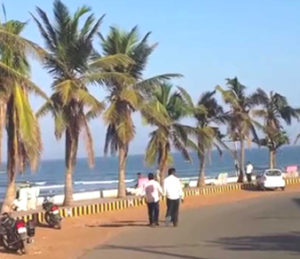
Bheemli is located on the mouth if River Gosthani – North east of Vishakhapatnam city. It’s beautiful beach and invigorating climate coupled with the pleasantness provided by the lush green palm groves adds to its immense attraction .It was the first municipality in Indian mainland, established on 9th February 1861.. It is also the site of the ruins of the east coast’s oldest Dutch settlement (17th century). The drive from Visakhapatnam to Bheemli is exhilarating. The cemetery situated in the west of the town speaks of the Dutch who gave their lives here. The unique feature of the cemetery is the depiction of the cause of the death on the grave enlivens the past. The beach road from Vizag to Bhimili is one of the longest and beautiful beach roads in India. The sun-kissed beaches enroute make the car drive enjoyable. You can enjoy the panoramic view of the Ghats on one side and the sea on the other. You may stop at different vantage points reroute to Bhimili as each and every spot is worth viewing.
Lighthouse At Bheemili
This famous lighthouse at the 17 century Dutch township of Bheemunipatnam near beach, built in 1868, the lighthouse, at present, is under the control of the Department of Ports, Government of Andhra Pradesh. Bheemunipatnam, the second municipality formed on February 9, 1861, celebrated its 150 year in 2011. The Ministry of Shipping, Transport, and Highways is to construct a new lighthouse, according to a government order on the same spot.
Red sand hills
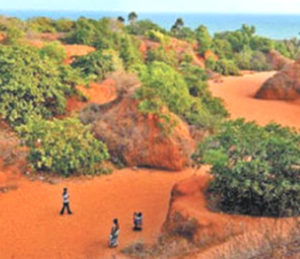
How the “Erra matti dibbalu” formed and what gave the sand its unique red color? These questions have challenged geologists since more than a century. Scientists are of the opinion that the initial chapter of this epic story started as far back as 1.8 million years ago and stretched across the broad canvas of geological time to around 10,000 years ago. During that time the sea level rose to as much as 150 feet and fell away a number of times to the current level. Between these oscillating sea levels the coast was submerged and exposed over and over again, huge volumes of clay, silt and sand covered the coast from where the sea water had receded. Due to the extreme changes in climatic conditions the material under the sandy dunes “baked” in the sun like a brick gets baked in a kiln leading to the peculiar red sand dunes. Subsequently action of the wind and flowing water caused the deeply gullied characteristic landscape.
Dutch Cemetery
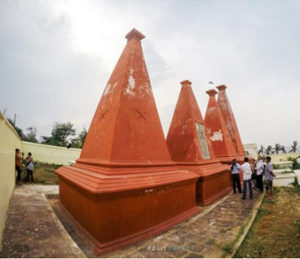
The cemetery situated in the west of Bheemili town at the sea beach speaks of the Dutch who gave their lives here. The unique feature of the cemetery is the depiction of the cause of the death on the grave enlivens the past, written in Portuguese. There are 52 tombs spread across two locations. Out of which 15 are stone capped and 5 of them have Dutch have inscriptions in Dutch language. These inscriptions are even visible today. One of pyramid shaped grave of Federick Kesslerus who died in Oct 8th 1661 is considered to be the earliest. This cemetery is divided in two parts, while entering to the right is for British people and rest of the area is for Dutch.
Thotlakonda
Thotalakonda a beautiful Buddhist Complex located on the beach road connecting Visakhapatnam and the historic town of Bheemli. Located at a height of 128 meters on a hill top this place was inside the Kalinga region which was instrumental in promoting Buddhism to Sri Lanka, Burma and many other places. Welcome gate by the side of the beach road with an entry fee and good tar road at the top of the hill is constructed by the local body. Thotlakonda Complex Meditation halls are designed to protect Monks from outside disturbances with stupas at the centre and guards at the entrance of the hall. The layout of Kitchen and resting place for Monks are still giving a glimpse of simple life led by them. The direction of Sun rise and sun set are marked in stones. Monks visiting this Buddhist school from far places like China, Burma and other countries came through the sea route and used to stay here for months and year before completing their study. The complex has number of Stupas, Chaityas and Viharas. There are many rocks cut trough available here. Out of the 12 tubs used for storing drinking water, four are available within the complex and others were little outside the area. One of the troughs at the top of the hill still holding water in the all the seasons and never went dry in past many years. Probably the Telugu name Thotlakonda is derived from the Thotti (tub) and Konda (hills).
Dolphin Nose – Yaradda
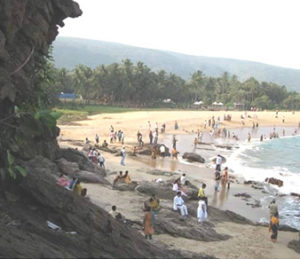
A spectacular beach view which even very few locals are aware of is called the “Yarada” beach. It’s a private beach with lot of greenery i.e. plantations this is nearer to the Dolphin nose. The view from Dolphin hill is spectacular. There is Ghat road leading one to the Dolphin hill and Yarada. Though a lovely beach it is not considered safe for swimming and playing. Hence do not jump inside the waters above the knee level as a best practice. Every year huge number of tourists throngs here to enjoy the beauty of nature with this untouched beach.
Ramakrishna Beach
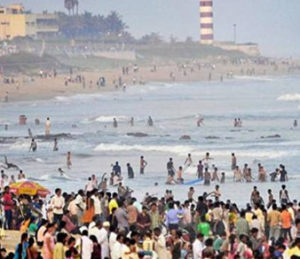
Ramakrishna Beach is the most popular beach of Visakhapatnam. With its serene waters and tranquil atmosphere, which is accessible to all city dweller as well as tourists. As it’s situated on the coastline, the beach overlooks the Bay of Bengal, along with its natural splendor. Infact, the marvelous landscape is beyond comparison. The natural harbour of Vishakhapatnam is to be found on the north-east of Ramakrishna Beach. Actually, this picturesque beach is the extension of the Coromandal Coast of India. Ramakrishna Beach has also got the glare of publicity. The vast stretch of blue waters juxtaposes the sight of bustling activities of the city on the opposite side. In the evenings, the beach gets crowded with both young and old, having fun time on the sands. Though not much, there are enough water sports available at the shore. Since Ramakrishna Beach comprises a large part of the water’s edge, it has got a huge area where different activities can take place simultaneously. You can take the local cruise to enjoy the sunset and sunrise amidst the tranquil waters. Apart from all this, you can take a ride in the traditional fishing boat by asking the fisher folk to arrange it for you. And for sure, Ramakrishna Beach would become an inseparable part of your most cherished memories.
Kailashgiri
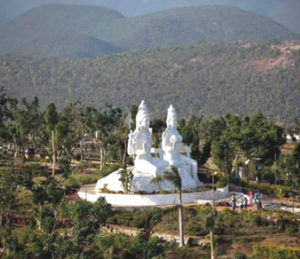
Kailasagiri is situated at an altitude of 360 ft. Is a charming hillock on the sea front bordering a small valley within the city? A ride on to this hill gives you a spectacular view of the sea, Bay of Bengal, R.K.Beach and Rushikonda Beach on right and left hand side. The magnificent statue of Shiva – Parvathi are illuminated at night and is worth seeing. Waterfall emanating from the statue is symbolic of the descent of the river Ganga. The local tale says that there was an ancient Shiva temple on the hill and it became popular as thousands of devotees started visiting the shrine regularly. So the hill was named after the deity.
The Shanku Chakra Naama which symbolizes the image of Lord Vishnu in its pristine form, fully lighted at night is visible from most parts of the city. The park gives an enchanting view of the sea, beaches, lush green forests and the bustling city. The titanic view point at Kailashgiri hill offers panoramic view of the Bay of Bengal as well as the City. Front Elevation looking like ship and resembling The “Titanic” this one of the prime attractions of Kalashgiri. Ropeway: A Ropeway that takes people from the foot to the top and back is an added attraction to this wonderful place. Sitting in the Cable Car you can have some of the magnificent views of the town and the Bay for you. The Rope has become the favorite for children as well as adults which thrills and tickles like anything. The Circular Toy Train: A ride on the glass top toy train which takes one in round trip the hill gives you a complete view of ocean; mountains and city make your visit a memorable one.
Kambalkonda
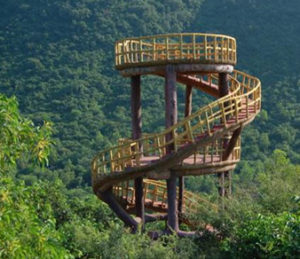
Is a wild life sanctuary just located by the side of National Highway? Kambalkonda Eco Tourism Park is located in an area of 71 sq KM out of which 0.8 sq KM of sanctuary is marked for community based eco-tourism project. While going round the park you will be greeted by spotted deer roaming inside the park. There is a small water storage system where rain water is stored and boating facility is available in this small lake. There are different trekking routs available inside Kambalkonda Park. There is a fee for a group of 10 members for trekking. One guide will accompany the group. The trekking starts early morning around 6 AM and it takes 3 hours to return. One day advance information is to be given at reception to make the arrangement for a guide.
TENATI PARK

This is the first point where you seem to distance yourself from the city noises to the heavenly other side of the mountain. Must go for all romantics, this is a real amazing place with the coast, mountains, city on all its sides. This place is photographer’s best choice, and also a sunrise point.
Indira Gandhi Zoological Park
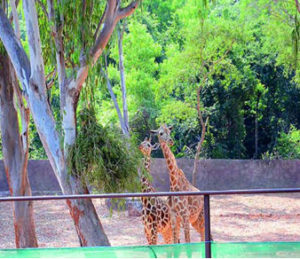
The one of the largest Zoological Park in Andhra Pradesh – next only to the one in Hyderabad and has a rich and varied collection of Wild Species including the Indian Tiger, Deer, Elephants and other attractions from Australia. Spread over 425 Acers of Land, the Zoo Park is a host for over 400 varieties of animals. The Indira Gandhi Zoological Park was setup in the year 1972 in the city outskirts of Visakhapatnam city in a 250 hector area. The park is a great spot to spend time – particularly in the months of November and December. The Zoo Park has some of the best living animal and marine species and is one of its kinds in the state of Andhra Pradesh. The park is refreshed with a fresh collection of animals from the forests of Africa and the Australia. The park is a great spot to spend time.
Submarine Museum
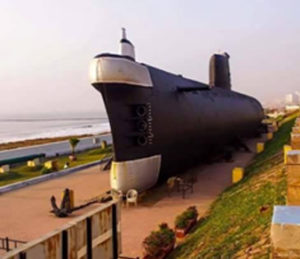
The Submarine Museum – INS Kurusura being set up at the Rama Krishna Beach in Visakhapatnam has a specialty. The Submarine Museum is the first submarine tuned to a museum in the whole of Asia and second in the World. INS Kusura is a Russian built submarine built on December 18, 1969. The submarine embarked on its journey on February 20, 1970 via the Baltic Sea and reached Visakhapatnam on the May 11, 1970. Since then INS Kusura is being used by the Indian Defense. The Submarine is tuned into a first Submarine Museum on February 27, 2001. It was earlier brought to the sands off the Vizag beach shores from the sea. India’s Premier Defense Lab – National Ship Design and Research Center (NSDRC), Oil and Natural Gas Corporation (ONGC), Visakhapatnam Port Trust (VPT) and other organizations have extended their helping hands in bringing the submarine to the sands of the beach and facilitating the conversion into a museum. INS Kusura served for about 31 years before it was decommissioned and retired from nation’s defense services.
Vuda Park
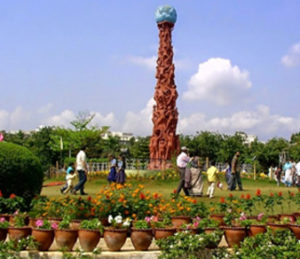
It is developed on the beachfront in an area of 55 acres. Out of which 37 acres covered with lawns, various species of flower plants, hedge plants and others. This park consists of around 2,500 shade-giving trees. Is a prominent recreation center for Vizagites and the visitors of Visakhapatnam? VUDA Park is one of the most visited spots in Visakhapatnam. It is the ideal place for all to spend evenings and leisure times on seashore with eye catching and eco-rich surroundings. The Park is well equipped with a variety of children play pens, boating club, musical fountains, a multi Gym, Yoga Center, Kala Vedika, Pagodas and many more. The Entrance Plaza extends makes the visitors have memorable moments of joy, every day lots of people visit here.
Kali Temple
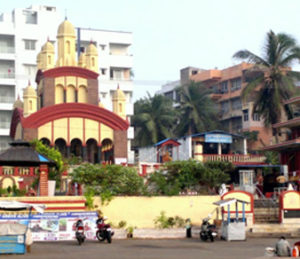
The Kali Temple located on Rama Krishna Beach road is a modern architectural edifice built on the model of the skeletal structure of a coral using bamboo reinforced cement concrete. Constructed in 1984, this shrine of the goddess of power (Shakti) is famous for its splendid architecture depicting tall pillars, arches and minarets. The temple complex houses an office, a quarter for the priest and a temple kitchen. Adjacent to the Kali temple there is another temple dedicated to Lord Siva. The uniqueness of Siva Temple is its ‘rasalinga’ which is made of 10 Kgs. single stone.
Ramanaidu Studio
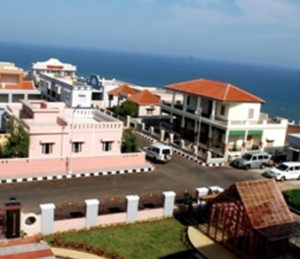
Situated on top of lushly green scenic beauty hillock on the way to Bhemili road, Rama Naidu Studio is a must visit spot of Vizag built 10 acres out of 33 acres of total land offers a mesmerizing ocean view. Owned by a famous Tollywood movie mughal Dr. Ramanaidu, a Guinness Books of Records holder, Dada Saheb Phalke Awarde, produced 130 movies which in self is a record. This place offers beautiful location for movies shooting which offers various beautiful structures and buildings indoor area beautiful landscaped gardens and many more this makes producers and directors from all areas makes Ramanaidu Studio as their first choice.
Vishaka Museum
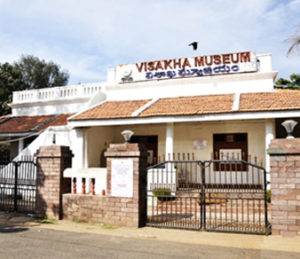
Visakhapatnam has volumes of history to talk about. But the credit of preserving records about the Visakhapatnam’s past goes to the Visakha Museum, also called Corporation Museum. The Visakha Museum is located at an Old Dutch Bungalow on the RK Beach Road. The Museum has some of the best and finest artistic items put on display. Portraits, some of them even at life-size depicting the members of the Royal family of the Vizianagaram and Bobbili, Two Armour suits, two stands of spears and muzzleloading guns, several ancient weapons such as steel bows, handguns that date back to the British-rule one should not miss.
The Visakha Museum also showcases some of the artifacts collected from other institutions. These include the 250-lb bomb that was dropped by the Japanese during the World War II. The shell bomb did not however explode. The shell bomb is now put on display at the Museum. The Museum preserves the coconut that was broken by the then Prime Minister Pt. Jawaharlal Nehru when he came for the inauguration of the first ship that was indigenously built – the S.S Jala Usha.
Fishing Harbour
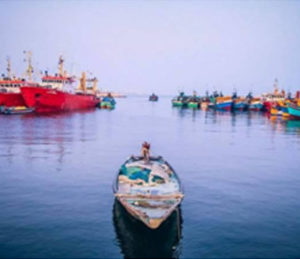
The Fishing Harbor at Visakhapatnam Port Trust is one of the biggest in the Coast of Andhra Pradesh. The harbor was set up in 1976 spreading across 24 hectors of land. This place also offers its tourist a joy ride on sea, run by APTDC which is really a thrilling one.
Simhachalam Temple

Simhachalam temple is a Hindu temple located in Andhra Pradesh, South India, and is dedicated to the incarnation (avatar) of Vishnu known as Narasimha (the man-lion).
Origin of the name SIMHA: Lion, Chala: hill Atop the hill is a famous temple said to be the abode of narasimha swami, and hence the hill itself is called (nara)simhachalam. The temple is situated in the city of Visakhapatnam in Andhra Pradesh.
Temple History
It has Sri Varahalakshmi Narasimha Swamy as the presiding deity. Simhachalam temple is known as the second richest temple (after Tirupati) earning a revenue of Rs. 520 million. The statue of the deity gives “nijaroopa darshan” (holy appearance in true form) for only 12 hours in a year i.e on Akshaya Tritiya day, the rest of the time the statue is covered with sandalwood paste. The darshan described as chandana yatra or chandanotsavam falls every year in Vaisakha masa (May). The deity at Simhachalam, the lion-man incarnation of Lord Mahavishnu is usually covered with sandalwood paste. The original shape of the deity in the tribhanga posture has two hands with the head of a lion on a human torso. An inscription dated as far back as 1098 AD of the Chola king Kuloththunga provides some clue as to its antiquity. Another inscription shows a Queen of the Eastern Ganga of Kalinga(ancient Orissa) (1137-56 AD) covering the image with gold while a third inscription says the eastern Ganga King of Orissa Narasimha Deva built the main/central shrine in 1267 A.D. With more than 252 inscriptions in Oriya and Telugu describing the antecedents of the temple, it is a historically important monument.
Sri Krishna Deva Raya after defeating the Gajapati ruler of Orissa Gajapati Prataparudra Dev visited the shrine twice in 1516 AD and 1519 AD and offered numerous villages for maintenance of bhogam (worship) along with valuable jewellery of which an emerald necklace is still in the temple. For the last three centuries the Royal family of Vizianagaram,” The Pusapati Gajapathi’s” have been the temple’strustees.This temple was build in the style of Orissa temple architecture. Legend Hiranyakasipu was a Rakshasa king. He was in fact one of Vishnu’s Dwarapalakas or gate keepers in Vaikuntha, Jaya and Vijaya. They had to take birth in the mortal world thrice because of a curse given by Sanaka, Sanandana, Sanathana and Sanathkumara, who were not allowed to take darshan of Mahavishnu by them. The other palaka was born as his brother Hiranyaaksha. Hiranyakasipu wanted to become immortal and hence performed austerities (tapasya) to propitiate Lord Brahma. However, Lord Brahma said that was not possible so Hiranyakasipu asked Lord Brahma to grant him a boon so that he could not be killed by any animal or a man neither in the morning nor in the night, by any weapons, neither in sky nor on the earth.
Hiranyakasipu wanted the entire world to worship him. But, Prahalada, his son, was a devotee of Lord Narayana and always expressed his bhakti towards Him. In spite of warning him several times, Hiranyakasipu could not alter Prahlada’s devotion. This made Hiranyakasipu angry and he made numerous attempts to get Prahlada killed. One of them was to throw him off the top of a mountain. However, Vishnu rescued him by moving the mountain and made a small path for Prahaladha. It is said that in the place where the Lord stood to protect Prahaladha is the place where the temple is built.
Sri Kanakamahalakshmi Temple

In so far as Sthalapuranam of this Temple is concerned, there is no authentic information. It is learnt that Sri Kanaka Maha Lakshmi Ammavaru is the family deity of the then “Rajas of Visakhapatnam”. The locality where the idol was found is called “Burujupeta” since it was near “Buruju” of the “Fort” of the then Rajas.
According to local story, in the year 1912, the Idol of Godess Sri Kanaka Maha Lakshmi Ammavaru was taken out from the well and it was installed at the center of the road i.e., ad midst the Municipal lane. The Municipal authorities, for the purpose of widening the road, have tried shifting the Idol from ad midst the road to a corner of the road. During which period i.e., in the year 1917 the dangerous contagious disease `Plague’ spread over the town with deaths occurred in Visakhapatnam village. The people of Visakhapatnam were afraid of the incident and thought the devastation was due to shifting of idol of goddess `Sri Kanaka Maha Lakshmi’ and therefore, re-erected Ammavari Idol to its original place i.e., at the center of the road as it existed now. Owing to re-eruption of the Plague disease was cured and normalcy was restored. With this, the villagers have a staunch belief that it is all due to miracle of Goddess. Thus from then onwards the Villagers used to worship the Goddess by performing sevas with much devotion. Further, the people of the vicinity have strong belief that ` Sri Kanaka Maha Lakshmi Ammavaru’ is the `MOTHER OF TRUTH’ and will always bless her devotees by fulfilling their requirements. The lady devotees have staunch belief that the Goddess blesses them with “Sumangali”. The devotees of Goddess bring their newly born babies to the temple and keep them at the feet of Goddess and seek blessings.


